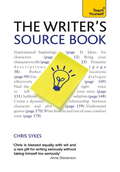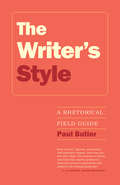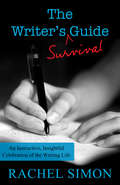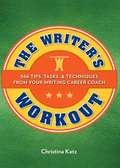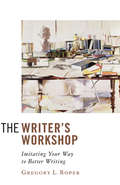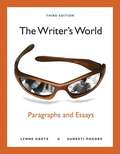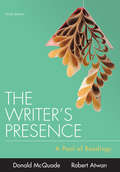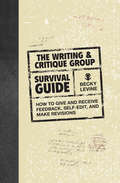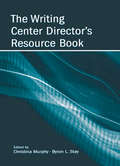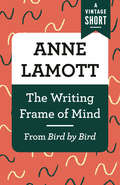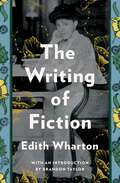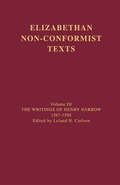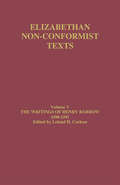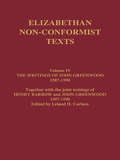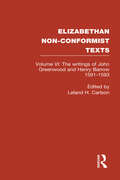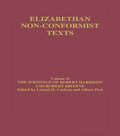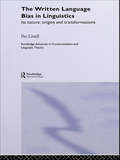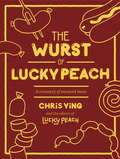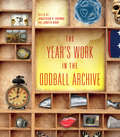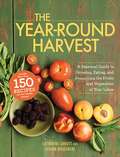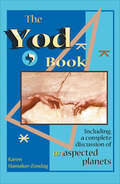- Table View
- List View
The Writer's Source Book: Teach Yourself
by Chris SykesIs your creative writing in need of inspiration? Do you need confidence to create watertight plots and believable characters?The Writer's Source Book provides dozens of practical exercises to help you create storylines, craft people and generate ideas, with support and creative insight for every stage.It will give you support in identifying your genre and crafting your work around it, and help you to understand the complexities of plot and character before beginning to create your own.Inspired and inspiring exercises will help you master the structure of your book, story or play, while focused and innovative advise will help those who have run into trouble. This is a technical manual ideal for any writer who needs to build, fix, polish or perfect their storyline.
The Writer's Style: A Rhetorical Field Guide
by Paul ButlerDesigned to help all writers learn to use style as a rhetorical tool, taking into account audience, purpose, context, and occasion, The Writer’s Style is not only a style guide for a new generation but a new generation of style guide. The book helps writers learn new strategies inductively, by looking at firsthand examples of how they operate rhetorically, as well as deductively, through careful explanations in the text. The work focuses on invention, allowing writers to develop their own style as they analyze writing from varied genres. In a departure from the deficiency model associated with other commonly used style guides, author Paul Butler encourages writers to see style as a malleable device to use for their own purposes rather than a domain of rules or privilege. He encourages writing instructors to present style as a practical, accessible, and rhetorical tool, working with models that connect to a broad range of writing situations—including traditional texts like essays, newspaper articles, and creative nonfiction as well as digital texts in the form of tweets, Facebook postings, texts, email, visual rhetoric, YouTube videos, and others. Though designed for use in first-year composition courses in which students are learning to write for various audiences, purposes, and contexts, The Writer’s Style is a richly layered work that will serve anyone considering how style applies to their professional, personal, creative, or academic writing.
The Writer's Survival Guide: An Instructive, Insightful Celebration of the Writing Life
by Rachel SimonThis inspirational guide for aspiring and experienced writers was originally published in 1997. Written in a friendly, hopeful, and gently humorous tone, it focuses on the creative process and emotional ups and downs of the creative life, providing insights into how to persist in the face of rejection, frustration, feelings of inadequacy, lack of support from loved ones, and more. It also offers practical how-to advice, from organizing your time so you actually sit down and write to reading as a writer. This ebook's rerelease of The Writer's Survival Guide includes a new introduction that discusses the origins of the book and how, in spite of the many changes in publishing and technology, it remains relevant today.
The Writer's Workout
by Christina KatzThe inspiration, stamina, and power to take charge of your writing life'every day. Get the daily jolt of energy your writing life needs fromThe Writer's Workout. Inside you'll find manageable, no-nonsense techniques for every aspect of your writing career from getting organized to connecting with your audience to building relationships. Veteran writing coach Christina Katz draws on her knowledge from more than a decade in the business to give you tips, exercises, and insider strategies to build your skills. Make your writing as strong and powerful as possible. Pitch and sell your work at every opportunity. Overcome rejection to come back better than ever. Promote your work and build an audience. Learn how to balance your creative life with your daily life. WithThe Writer's Workout, you'll develop skill, strength, and confidence ? everything you need to build a robust, unique writing career that's built to last. Bonus online exclusive: Download a free motivational poster to keep you moving as your build your writing career at writersdigest. com/writers-workout.
The Writer's Workout
by Christina KatzThe inspiration, stamina, and power to take charge of your writing life--every day.Get the daily jolt of energy your writing life needs from The Writer's Workout. Inside you'll find manageable, no-nonsense techniques for every aspect of your writing career from getting organized to connecting with your audience to building relationships.Veteran writing coach Christina Katz draws on her knowledge from more than a decade in the business to give you tips, exercises, and insider strategies to build your skills.Make your writing as strong and powerful as possible.Pitch and sell your work at every opportunity.Overcome rejection to come back better than ever.Promote your work and build an audience.Learn how to balance your creative life with your daily life.With The Writer's Workout, you'll develop skill, strength, and confidence - everything you need to build a robust, unique writing career that's built to last.Bonus online exclusive: Download a free motivational poster to keep you moving as your build your writing career at writersdigest.com/writers-workout.
The Writer's Workshop: Imitating Your Way to Better Writing
by Gregory L. RoperThe Writer’s Workshop takes an approach to teaching writing that is new only because it is so old. Today, rhetoric and composition typically proceed by ignoring what was done for 2,500 years in Western education. Gregory Roper, on the other hand, helps students learn to write in the way the great writers of the past themselves learned: by carefully imitating masters of the craft, including Cicero, Thomas Aquinas, Charles Dickens, Sojourner Truth, James Joyce, and Ernest Hemingway. By living in their workshops and apprenticing to these and other masters, apprentice writers—like apprentice musicians, painters, and blacksmiths of the past—will rapidly improve the complexity of their art and discover their own native voices.Interspersed into chapters full of sound practical advice and challenging assignments are reflections on Great Ideas from “Realism and Impressionism” to “Nominalism and Modern Science.” Perfect for the college or even high school writing classroom—as well as a marvelous book for homeschoolers and others who would like to improve their own writing—The Writer’s Workshop is a fine practical guide, and Dr. Roper a friendly yet demanding teacher-mentor.
The Writer's World: Paragraphs and Essays (3rd Edition)
by Lynne Gaetz Suneeti PhadkeThe Writer's World series was written to address the diverse needs of today's students: students whose first language is not English, students who respond favorably to visuals, and students who have varying skill levels.
The Writer’s Presence
by Robert Atwan Donald McQuadeMemorable. Provocative. Timely. Luminous. The Writer's Presence brings together the best of the essay genre in a teachable, flexible compendium, because great reading inspires great academic writing. Edited by Best American Essays series editor Robert Atwan and composition teacher and scholar Donald McQuade, The Writer's Presence offers a rich pool of readings you'll enjoy dipping into. The essays here address topics students care about, from race in America to transgender identity, with careful attention to voice, tone, and figurative language. Classic authors like Langston Hughes and George Orwell join rising stars like Roxane Gay and Eula Biss for a grand tour of masterful writing. Divided into three parts--personal writing, expository writing, and argumentative writing--The Writer's Presence also provides practical strategies for student writers, giving them tools to sharpen their own voices and imagination. An e-book option offers even greater flexibility and convenience.
The Writing & Critique Group Survival Guide: How to Make Revisions, Self-Edit, and Give and Receive Feedback
by Becky LevineTrying to Finish Your Book? There's Strength in Numbers Whether you're trying to revise your novel or polish up an article to pitch to magazines, it pays to have a few sets of eyes look over your work. But, how can you be sure you're getting an unbiased and objective opinion? A writing critique group may be the answer you're looking for, and this book arms you with everything you need to find a group that suits your specific writing needs. Whether you're looking to join an existing group or start one of your own, you'll learn how to: Find compatible critique partners Develop your "editor's eye" and analyze writing like a professional Construct organized and well thought-out critiques Give and receive constructive feedback Run efficient critique meetings and maintain a good group dynamic Apply the feedback you receive to your own writing and make revisions Complete with worksheets, sample critiques and examples,The Writing & Critique Group Survival Guidegives you tools to hone your editing skills and deepen your understanding of how to revise your own work as well as someone else's. With the help of this guide your writing critique group can be a helpful resource for you and your writing partners for years to come.
The Writing Center Director's Resource Book
by Christina Murphy Byron L. StayThe Writing Center Director's Resource Book has been developed to serve as a guide to writing center professionals in carrying out their various roles, duties, and responsibilities. It is a resource for those whose jobs not only encompass a wide range of tasks but also require a broad knowledge of multiple issues.The volume provides information on the most significant areas of writing center work that writing center professionals--both new and seasoned--are likely to encounter. It is structured for use in diverse institutional settings, providing both current knowledge as well as case studies of specific settings that represent the types of challenges and possible outcomes writing center professionals may experience. This blend of theory with actual practice provides a multi-dimensional view of writing center work.In the end, this book serves not only as a resource but also as a guide to future directions for the writing center, which will continue to evolve in response to a myriad of new challenges that will lie ahead.
The Writing Frame of Mind: From Bird by Bird (A Vintage Short)
by Anne LamottA Vintage Shorts selection. To the enormous challenges of being a writer, Anne Lamott offers invaluable advice and encouragement, which more than a million scribes and scribblers of all ages and abilities have been inspired by for a quarter century. In this selection from her essential volume, Bird by Bird, Lamott tenderly recommends and outlines the qualities that every writer should learn to hone: intuition, attention, morality, and more. An ebook short.
The Writing of Fiction: The Classic Guide To The Art Of The Short Story And The Novel (The\collected Works Of Edith Wharton)
by Edith WhartonA rare work of nonfiction from Edith Wharton, The Writing of Fiction contains brilliant advice on writing from the first woman ever to win a Pulitzer Prize -- for her first novel The Age of Innocence. In The Writing of Fiction, Wharton provides general comments on the roots of modern fiction, the various approaches to writing a piece of fiction, and the development of form and style. She also devotes entire chapters to the telling of a short story, the construction of a novel, and the importance of character and situation in the novel. Not only a valuable treatise on the art of writing, The Writing of Fiction also allows readers to experience the inimitable but seldom heard voice of one of America's most important and beloved writers, and includes a final chapter on the pros and cons of Marcel Proust.
The Writings of Henry Barrow, 1587-1590: The Writings Of Henry Barrow 1587 1590 (Routledge Library Editions Ser.)
by Henry BarrowHenry Barrow and John Greenwood are the fathers of Elizabethan Separatism. Unlike Robert Browne, they refused to compromise their beliefs or conform to Anglicanism and as a consequence they died in 1593 - as martyrs for their steadfast adherence to the principles of English Congregationalism. Volumes three and four include c. 40 items derived from manuscripts, surreptitiously printed books and very rare pamphlets and documents which allow evaluation of the teachings of the Separatists, in relation to the activities of the Elizabethan hierarchy, to the Puritans, to the Pilgrims in the Netherlands and the New World and to the Independents and Congregationalists. (16 of the pieces are by Barrow, 6 by Greenwood and 5 by both men, in addition to 13 related Barrowist items in the Appendix).
The Writings of Henry Barrow, 1590-91: The Writings Of Henry Barrow 1590-1591 (Routledge Library Editions Ser.)
by Leland H. CarlsonThis volume contains the great Separatist's solus writings from 1590-1591. It includes texts taken from manuscript sources, and rare tracts that have been reprinted here for the first time.
The Writings of John Greenwood 1587-1590: Together with the Joint Writings of Henry Barrow and John Greenwood 1587-1590 (Elizabethan Non-Conformist Texts #IV)
by John GreenwoodHenry Barrow and John Greenwood are the fathers of Elizabethan Separatism. Unlike Robert Browne, they refused to compromise their beliefs or conform to Anglicanism and as a consequence they died in 1593 - as martyrs for their steadfast adherence to the principles of English Congregationalism. Volumes three and four include c. 40 items derived from manuscripts, surreptitiously printed books and very rare pamphlets and documents which allow evaluation of the teachings of the Separatists, in relation to the activities of the Elizabethan hierarchy, to the Puritans, to the Pilgrims in the Netherlands and the New World and to the Independents and Congregationalists. (16 of the pieces are by Barrow, 6 by Greenwood and 5 by both men, in addition to 13 related Barrowist items in the Appendix).
The Writings of John Greenwood and Henry Barrow 1591-1593 (Routledge Library Editions Ser.)
by John GreenwoodVolumes five and six contain c. 25 pieces of manuscript material, or rare tracts many of which have been available for the first time.
The Writings of Robert Harrison and Robert Browne (Elizabethan Nonconformist Texts)
by Leland Carlson Albert PeelRobert Harrison and Robert Browne were the initiators of the principles of English Separatism and Congregationalism. Unlike the Presbytero-Puritans, these nonconformists sought to establish local churches that were independent of the state. Although they encountered fierce opposition from the clergy, state officials and Anglican bishops, they persisted in their practices. As a result, the ideas of these two men profoundly influenced the Puritan movement both of England and America. In this volume, scarce and little known works, as well as new material derived from manuscripts and tracts are collected into one volume.
The Written Language Bias in Linguistics: Its Nature, Origins and Transformations (Routledge Advances in Communication and Linguistic Theory)
by Per LinellLinguists routinely emphasise the primacy of speech over writing. Yet, most linguists have analysed spoken language, as well as language in general, applying theories and methods that are best suited for written language. Accordingly, there is an extensive 'written language bias' in traditional and present day linguistics and other language sciences. In this book, this point is argued with rich and convincing evidence from virtually all fields of linguistics.
The Wurst of Lucky Peach: A Treasury of Encased Meat
by Chris Ying the editors of Lucky PeachThe best in wurst from around the world, with enough sausage-themed stories and pictures stuffed between these two covers to turn anyone into a forcemeat aficionado.Lucky Peach presents a cookbook as a scrapbook, stuffed with curious local specialties, like cevapi, a caseless sausage that's traveled all the way from the Balkans to underneath the M tracks in Ridgewood, Queens; a look into the great sausage trails of the world, from Bavaria to Texas Hill Country and beyond; and the ins and outs of making your own sausages, including fresh chorizo.From the Hardcover edition.
The Year's Work in the Oddball Archive (The Year's Work: Studies in Fan Culture and Cultural Theory)
by Grant Farred Timothy Sweet Aaron Jaffe Joseph Campana Charles M. Tung Dennis Allen Theodore Bale Atia Sattar Beth A. McCoy Robin Blyn Seth Morton&“By playing with notions of collecting and cataloging, this anthology offers a range of investigations into detritus and forgotten ephemera.&”—Colin Dickey, coeditor of The Morbid Anatomy Anthology The modern age is no stranger to the cabinet of curiosities, the freak show, or a drawer full of odds and ends. These collections of oddities engagingly work against the rationality and order of the conventional archive found in a university, a corporation, or a governmental holding. In form, methodology, and content, The Year&’s Work in the Oddball Archive offers a counterargument to a more reasoned form of storing and recording the avant-garde (or the post-avant-garde), the perverse, the off, the bent, the absurd, the quirky, the weird, and the queer. To do so, it positions itself within the history of mirabilia launched by curiosity cabinets starting in the mid-fifteenth century and continuing to the present day. These archives (or are they counter-archives?) are located in unexpected places—the doorways of Katrina homes, the cavity of a cow, the remnants of extinct animals, an Internet site—and they offer up &“alternate modes of knowing&” to the traditional archive. &“An unruly―and much-needed―model for how to do the archive differently.&”—Scott Herring, author of The Hoarders: Material Deviance in Modern American Culture &“It was a pleasure to read through this collection, and I suspect some of the essays, if not the entire book, will find itself on the syllabus for my Archive and Ephemera graduate course.&”—Museum Anthropology Review &“A finely wrought collection of curiosities . . . A vital intervention into how we talk about the stuff that surrounds us.&”—Colin Dickey, coeditor of The Morbid Anatomy Anthology
The Year-Round Harvest
by Catherine Abbott Alison WoitunskiDo you . . . . . . love harvesting juicy heirloom tomatoes--but are at a loss for how to extend their shelf life? . . . dig up buckets full of robust potatoes--but don't know how to store them to resist rot? . . . dream about growing vibrant, crisp greens into the colder months--but can't come up with a system that works? If so, this book is for you. Inside, you'll find all you need to grow and store an abundance of fresh food that will leave you wanting more! Complete with variables to consider given your own growing situation, this one-stop guide features illustrations and trusted advice for getting your hands dirty and planting with preservation in mind. In addition, you get 150 recipes--from Roasted Red Pepper Pesto and Dried Tomato Risotto to Lavender Blueberry Jam and Fresh Mint Chutney--that help you make your just-picked, homegrown harvest work for you in the most delicious and satisfying way. With this valuable resource, you can forget limp grocery store offerings and instead enjoy your very own bright, flavorful--and nutritious--produce that's in seasonevery season!
The Year-Round Harvest
by Catherine AbbottDo you . . .. . . love harvesting juicy heirloom tomatoes--but are at a loss for how to extend their shelf life?. . . dig up buckets full of robust potatoes--but don't know how to store them to resist rot?. . . dream about growing vibrant, crisp greens into the colder months--but can't come up with a system that works?If so, this book is for you. Inside, you'll find all you need to grow and store an abundance of fresh food that will leave you wanting more! Complete with variables to consider given your own growing situation, this one-stop guide features illustrations and trusted advice for getting your hands dirty and planting with preservation in mind.In addition, you get 150 recipes--from Roasted Red Pepper Pesto and Dried Tomato Risotto to Lavender Blueberry Jam and Fresh Mint Chutney--that help you make your just-picked, homegrown harvest work for you in the most delicious and satisfying way.With this valuable resource, you can forget limp grocery store offerings and instead enjoy your very own bright, flavorful--and nutritious--produce that's in season every season!
The Year-Round Harvest: A Seasonal Guide to Growing, Eating, and Preserving the Fruits and Vegetables of Your Labor
by Catherine AbbottDo you . . .. . . love harvesting juicy heirloom tomatoes--but are at a loss for how to extend their shelf life?. . . dig up buckets full of robust potatoes--but don't know how to store them to resist rot?. . . dream about growing vibrant, crisp greens into the colder months--but can't come up with a system that works?If so, this book is for you. Inside, you'll find all you need to grow and store an abundance of fresh food that will leave you wanting more! Complete with variables to consider given your own growing situation, this one-stop guide features illustrations and trusted advice for getting your hands dirty and planting with preservation in mind.In addition, you get 150 recipes--from Roasted Red Pepper Pesto and Dried Tomato Risotto to Lavender Blueberry Jam and Fresh Mint Chutney--that help you make your just-picked, homegrown harvest work for you in the most delicious and satisfying way.With this valuable resource, you can forget limp grocery store offerings and instead enjoy your very own bright, flavorful--and nutritious--produce that's in season every season!
The Yod Book: Including A Complete Discussion Of Unaspected Planets
by Karen Hamaker-ZondagAn explanation of atypical horoscope configurations, with analyses of celebrity birth charts to see how these astrological patterns play out in real life.A yod is formed when two planets that are sextile also form an inconjunct to another planet. These planets are in different signs and modes and are deeply significant, for they usually symbolize patterns in families that have lasted for generations. This is what Hamaker-Zondag discovered when she started to research the inconjunct aspect as it related to a yod. Also included in this book is a complete discussion of how the energies of unaspected planets, and planets in duet (that only aspect each other) are expressed in a person’s birth chart. Hamaker-Zondag analyzes the background and places it in a broader perspective, including how she works with elements, modes, orbs, and other astrological factors when interpreting this aspect. All in all, this is one of the most exciting books on aspect interpretation published in recent years!Included are great case histories: you have a chance to examine the Monica Lewinsky, Linda Tripp, Kenneth Starr, Bill Clinton scenario. And Princess Diana, Prince Charles, and Prince William are not without these family patterns. She uses the examples of Gandhi, Vaclav Havel, Khomeini, Solzhenitsyn, Willy Brandt, C. G. Jung, Jim Jones, and others. To help you work with your own clients, Hamaker-Zondag brings in the charts of her personal clients and explains them in depth.When you’ve read this book, you’ll want to check out the charts of everyone you know!
The Yoga of Herbs: An Ayurvedic Guide to Herbal Medicine (Second Revised & Enlarged Edition)
by David Frawley Vasant LadFor the first time, here is a detailed explanation and classification of herbs, using the ancient system of Ayurveda. More than 270 herbs are listed, with 108 herbs explained in detail. Included are many of the most commonly used western herbs with a profound Ayurvedic perspective. Important Chinese and special Ayurvedic herbs are introduced. Beautiful diagrams and charts, as well as detailed glossaries, appendices and index are included.
